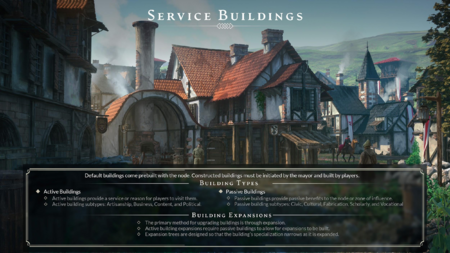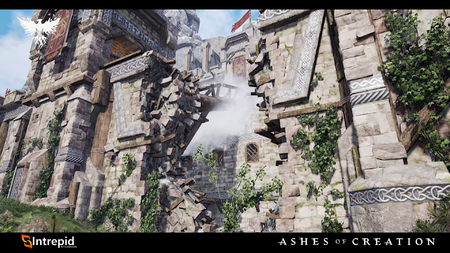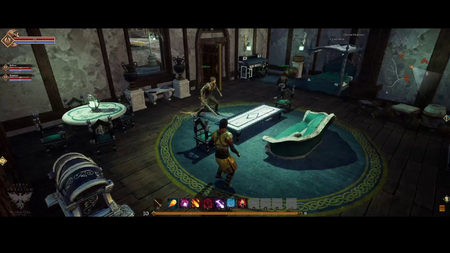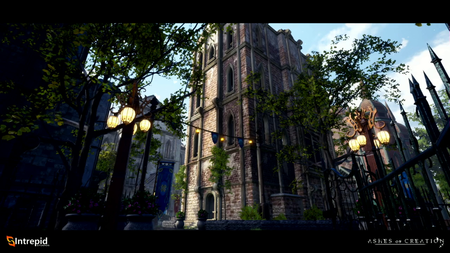Node layout and style

Das Layout und die Architektur innerhalb des Siedlungsgebiets einer Node werden durch die einflussreichste Volk bestimmt. Eine Node der Stufe 3, bei dem die Mehrheit der Spieler Py'rai sind, wäre zum Beispiel ein Py'rai-Dorf mit Py'rai-Architektur. Die meisten NSCs wären Py'rai-Elfen und würden Questlinien innerhalb der Py'rai-Erzählung anbieten.[1] – Margaret Krohn
Der Beitrag eines jeden Spieler wird mit dem entsprechenden Volk und anderen Faktoren makiert. Wenn eine Node aufsteigt, bestimmt das Volk dass am meisten beigetragen hat, den Stil und die Kultur der Node. Dieser Stil und Kulturwechsel kann bei jedem Stufenaufstieg statt finden. Wenn zum Beispiel eine Node auf Stufe 2 – Lager – aufsteigt und 51% der Beiträge von Ren’Kai kamen, wird die Node im Stil der Ren’Kai sein. Wenn die selbe Node zur Stufe 3 - Dorf – aufsteigt und Py’Rai 62% der gesammten Leistung beigetragen haben, dann ist die Node ein Py’Rai Dorf.[2] – Margaret Krohn
Das Layout und der Stil einer Node wird durch viele Faktoren bestimmt:[3][4]
- Das Node-System ist so konzipiert, dass diese in 18 verschiedenen Biomen existieren können, aber gleichzeitig die kulturellen Merkmale eines Volkes repräsentieren werden, die fester Bestandteil eines spezifischen Bioms sind.[5] – Steven Sharif
- Umgebung (Biome) und Standort der Node.[5][3][4]
- Die Node passt die lokale Topographie an die ästhetischen und strategischen Anforderung der Node an.[6]
- Derzeit ist das Plattformsystem so konzipiert, dass es die Topografie der Stellfläche der Node unabhängig vom umgebenden Terrain anpassen kann. Der Grund dafür ist, dass wir bei der Gestaltung des Node-Layouts flexibel sein wollen, und zwar sowohl aus ästhetischer Sicht als auch aus mechanischer Sicht mit den Node-Belagerungen - wie sie aufgebaut sind, und diese Bauweise sollte in der Lage sein, eine Vielzahl verschiedener Arten von Topografien zu berücksichtigen. Das heißt, es sollte nicht von der Umgebung abhängig sein. Das heißt aber nicht, dass die Umgebung nicht einen gewissen Einfluss haben wird. Wir experimentieren zum Beispiel ein wenig mit der Plattformtechnologie und stellen eine Node an die Seite eines Berges, am Rande einer Klippe oder an einem Standort, der eine schöne Aussicht bietet. Das sind natürlich Dinge, die wir ausprobieren werden, während wir weiter am Node-Tool arbeiten und daran, wie das Plattformsystem funktioniert, aber die Idee ist, dass die Nodes unabhängig vom umgebenden Terrain sind.[6] – Steven Sharif
- Einige Teile werden durch das Gebiet bestimmt, in dem sie sich befinden. Einige Teile werden durch den Typ bestimmt, der sie ist. Einige Teile werden durch die Völker bestimmt, und der Rest wird vom Bürgermeister bestimmt.[4] – Jeffrey Bard
- Das Volk, dass am meisten zum Fortschritt einer Node beigetragen hat, wird die Ästhetik der Gebäude, NPCs und Ausstattung bestimmen.[7][8][3][2][4][9][10]
- Das übergeordnete Volk werden nicht ihre kulturellen Einflüsse kombinieren. Zum Beispiel zählen die Py'Rai und Empyrean als verschiedene Kulturen. Das übergeordnete Volk, die Pyrian, existieren nicht mehr.[11]
- Der Stil und die Kultur einer Node kann sich bei jedem Aufstieg verändern.[2]
- Das trifft auf alle Nodes zu, Burg-Nodes eingeschlossen.[12]
- Alle Nodes, unabhängig davon, ob sie mit einer Burg oder mit einer normalen Node-Struktur verbunden sind, unterliegen kulturellen Einflüssen, die sich auf die gebauten Gebäude und die vorhandenen NPCs auswirken.[12] – Steven Sharif
- Der Rest wird vom Bürgermeister bestimmt.[4]
- Es wird möglich sein, dass eine Node mehrere Bauprojekte innerhalb der einmonatigen Amtzeit eines Bürgermeisters fertig stellt.[13]
- Q: Wie lange werden die Spieler im Durchschnitt brauchen, um einen Node komplett von der Wildnis bis zur Metropole zu bewohnen/auszubauen?
- A: Es ist eine Sache, eine Node auf ein bestimmtes Niveau zu bringen: es ist eine andere Sache, diese Node weiter zu entwickeln; und ich kann dir nicht wirklich eine Durchschnittsvorhersage geben, weil eine Menge Variablen im Spiel sind. Es geht darum, wie viele Bürger die Node angezogen hat; welche Art von Verkehr die Node anzieht, basierend auf Dingen wie seinen Steuersätzen oder der Spezialisierung, die sie gewählt hat, basierend auf den Gebäudetypen, die sie gebaut hat. All diese Dinge sind Variablen, die die "durchschnittliche Ausbaudauer" einer bestimmten Node beeinflussen können. Es ist also schwierig, einen Durchschnittswert anzugeben, wenn es so viele Variablen in diesem Bereich gibt. Aber die Idee ist, dass wenn es ein bestimmtes Projekt gibt, an dessen Entwicklung die Spieler interessiert sind, basierend auf der Node-Stufe, dass sie die Möglichkeit haben, mehrere dieser Projekte innerhalb einer einzigen Amtszeit eines Bürgermeisters abzuschließen; und eine Amtszeit eines Bürgermeisters ist ein Monat.[13] – Steven Sharif
Node-Gebäude

The important thing with the service building system for us is that it's a way to shape your node like a character; and to give you an exclusive niche that you can carve out in the world; or a niche that you fight over. If you go down this weaponsmithing path and you build your node to be this mecca of weaponsmithing and the node three doors down builds it, there's reason for you to conflict over it. They're taking your business. Or maybe you are in a zone and there isn't a weaponsmithing thing anywhere near you, and you do want to start to carve that path for yourself to make your node a place people visit and come to.[15] – Chris Justo
Service buildings within a node are either default buildings that come with the node, or they are constructed buildings, which are initiated by the mayor and built by players.[14][15][16][17][18][19][20] Service buildings are further broken down into two main types:[14][15]
- Active service buildings are service buildings that players directly interact with. These are further broken down into Artisanship, Business, Content, and Political categories.[14][15]
- Passive service buildings provide passive benefits to the node or its zone of influence. These buildings are broken down into Civic, Cultural, Fabrication, Scholarly, and Vocational.[14][15]
- Constructed service buildings are available to every type of node in every location. Where the uniqueness comes in is in some of the default buildings like your node-type building.[21] – Chris Justo
Service buildings are upgraded by expansions, which are unlocked through the placement of passive service buildings.[14][15]
- Building expansions unlock higher tier workstations at the cost of dedicating service building plots.[22][18]
- Node service building expansions specialize the building through a tech tree based on the stage of the node.[23][24]
Service buildings incur a regular maintenance cost of node commodities and gold from the node treasury in order to continue operations.[14][25]
Unique node buildings
Jeder Art von Node ist ein einzigartiges Node-Gebäude zugeordnet, das ab der Entwicklungsstufe Dorf der Node aktiviert werden kann. Dieses einzigartige Gebäude spielt eine zentrale Rolle in dem Fortschritt der Zivilisation eines Server.[27]
Node building destruction

You could be more precision oriented in the decision to attack a city. Let's say it's a rival node that's trying to reach a node stage five or something and you want to disable their ability for the religious system to progress so you target the temple during the attack, or you want to disable their scholars academy from reaching a higher level so that your nodes can; or you want to disable multiple buildings that allow for experience and quests to be undertaken by its citizenship, which prevents them from keeping up in pace of experience gained with your node. These can be more precision oriented and don't have to effectualize an actual takeover of the node.[29] – Steven Sharif
Node-Gebäude (including player housing) have hit points and can be damaged or destroyed by different systems.[24][30]
- NPC-driven events that are a response to story arcs or node atrophy.[24]
- Node-Belagerungen and node wars.[24]
- Attackers may not be capable of destroying a node during a siege. Instead they may carry out precision attacks to disable specific service-oriented buildings within the node. These buildings can be targeted with siege weapons and bombs.[29]
- Hazardous events such as tornadoes or hurricanes.[31][24]
- Bürgermeister have the ability to demolish constructed node buildings. This will have a node mandate cost and will require player buy-in via a vote.[14][25]
- Mayors will also have the ability, if they want, to demolish constructed buildings. So if they if they so choose they can destroy a building if they don't think it's needed anymore. But this will have mandate cost and a player buy-in votes. So we want to make sure that [the] mayor can't just go and blow up the whole node if they're trying to grief or something. So this is very important and impactful decision.[14][25] – John Collins
If building maintenance is not paid, or a building is damaged as the result of an event or siege, the building will enter a state of disarray.[14][25] Any NPCs or services offered by that building will not be available until the building is repaired.[17][30]
- Players must contribute materials to repair disarrayed buildings and restore them to an operational state.[14][25][24][30][32]
If a node siege is successful, or if buildings otherwise take significant damage, they are destroyed and appear as rubble on the plot they occupied.[14][25][24]
- Node-Regierungen must clear any rubble on plots before any buildings can be reconstructed. Any prerequisites for the building reconstruction must be satisfied beforehand.[24]
- Buildings also live within a prerequisite system. So in order to build down the tech tree of what these buildings provide, as the node grows larger to access stronger building types, you may get a kink in that chain if it's destroyed and you'll have to stand that back up in order to support the service again.[24] – Steven Sharif
- If the node is destroyed by a node siege, the debris field will contain spoils that are lootable by attackers or defenders.[33][34][35][30][36][37]
- Spielerbehausungen that is destroyed during a node siege can no longer be sold.[38] Furnishing and decorations are retained and can be placed again later.[38][39][40]
Static housing development

If the node advances players can essentially select an option on their house as they own it that they want it to upgrade to the next stage if the node advances or they can select an option not to upgrade it. So you as the node levels and larger homes become available, the town stage introduces additional medium types housing, the city stage introduces large sized homes, and in the metropolis stage introduces my mansion size houses each of which contain specific... allowances and allotments for different types of furnishings that have gameplay implications.[41] – Steven Sharif
In-node housing can scale in size with the advancement of its parent node. This may be toggled on or off by the player.[41][42]
- The Dorf stage offers small housing types.[41]
- The Stadt stage introduces medium housing types.[41]
- The Großstadt stage introduces large sized homes.[41]
- The Metropole stage introduces mansion size houses.[41]
If you choose to keep the same size then the next stage will have an occupied small home. So for instance if at stage three there are 8 small home and you own 1, then at stage 4 there are 10 new small homes of which x are owned by previous owners, and 10 new medium homes of which x are owned by upgraded small home owners.[43] – Steven Sharif
New property becomes available at each stage of advancement, but it will be more akin to what was available at the previous stage.[42]
- Only the houses that existed at the Dorf stage will become main street mansions at the Metropole stage.[42]
Node redevelopment
A node that was successfully destroyed by a node siege may develop differently due to the following influences:[3][44]
- Different races becoming primary contributors.[3][44]
- Design elements determined by different governments.[3][44]
- Reactions and interactions with other nodes in the world.[3][44]
Artistic style
Ashes of Creation wird eine höhere grafische Treue haben als die meisten westlichen Spiele. Es wird nicht zu stilisiert oder "cartoonisiert" sein.[45]
- Alle künstlerischen Elemente im Ashes of Creation Apocalypse Battle Royale Testmodus wurden von Intrepid Studios erstellt.[46]
Wir können die Grenzen der grafischen Wiedergabetreue ein wenig verschieben, insbesondere mit der Unreal Engine 4 ... Mein Wunsch war es, keine sehr cartoonartigen Spiele zu sehen. Ich bin kein großer Fan von stark stilisierter Kunst.[45] – Steven Sharif
Künstlerische Einflüsse
Charakterrassen sind super wichtig. Dies sind die Entscheidungen, die wir zu Beginn unseres Abenteuers in einem MMORPG treffen: Welche Rasse – stimmt nicht nur mechanisch mit unseren Entscheidungen überein, wenn diese Rassen aus statistischer Sicht Spielmechaniken hinter sich haben, sondern auch visuell, kulturell und historisch: Was sind diese? Was stellen diese Rassen dar? Daher ist es wichtig, dass sie sich optisch unterscheiden. Und jeder hat Fantasy-Spiele bei Elfen gesehen, also hat jeder sie bei Menschen gesehen, jeder hat sie bei Orks gesehen: Es gibt fast eine etablierte Erwartung hinter dem, was diese traditionellen Fantasy-Rassen darstellen; Und es besteht ein Risiko, denn wann immer Sie ein neues IP oder eine neue Geschichte oder eine neue Welt erschaffen – ein neues Universum; In einem Bereich, in dem die Dinge nicht immer die Norm sein müssen, können Sie sich ein wenig kreative Freiheit nehmen, um einige Aspekte einer bestimmten Rasse neu zu definieren. und das kann eine gute Sache sein, denn es ist etwas, das für Spieler neu ist. Es ist etwas Einzigartiges für den Bereich, den wir aufbauen – die Umgebung, die Sie haben. Was wir also tun wollten, war, die Einzigartigkeit des Py'rai aus visueller Sicht ein wenig stärker hervorzuheben.[47] – Steven Sharif
- Die Architektur der Aelan hat einen französisch-mittelalterlichen Einfluss.[48]
- Dünir haben einen nordischen kulturellen Einfluss. [49]
- Empyreanhaben ein griechisch-römisches imperialistisches Gefühl.[50]
Die Kaelar haben einen europäischen Rasseneinfluss. [51]
- Die Niküa haben einen polynesischen Einfluss.[52][50]
- Die Py'Rai haben einen Einfluss der Navajo Indianer.[50] Die Py'Rai Architektur ist vom Wald inspiriert.[53][54]
- Die Pyrian Architektur weist einen griechisch-römischen Einfluss auf.[55]
- Die Vaelune haben einen nahöstlichen Rasseneinfluss. [56]
- Die Vek haben einen mesoamerikanischen Einfluss. [56]
Ihr werdet in den verschiedenen Rassen, die aus Sicht des Spielercharakters zur Verfügung stehen, viele verschiedene Einflüsse erkennen, die viele Kulturen auf der Welt widerspiegeln: Nicht nur Europäer, nicht nur Afrika, nicht Mesoamerikaner. Diese Kulturen werden in vielen Rassen präsent sein[57] – Steven Sharif
Die Idee besteht lediglich darin, eine Basiskomponente in der realen Welt als Ausgangspunkt zu finden und dann mit der Fantasie zu beginnen.[48] – Steven Sharif
Siehe auch
Einzelnachweise
- ↑ Blog - Know Your Nodes - The Basics.
- ↑ 2.0 2.1 2.2 Blog - Know Your Nodes - Advance and Destroy.
- ↑ 3.0 3.1 3.2 3.3 3.4 3.5 3.6 Liveübertragung, 2020-10-30 (39:17).
- ↑ 4.0 4.1 4.2 4.3 4.4 4.5 Liveübertragung, 2018-09-27 (53:06).
- ↑ 5.0 5.1 Liveübertragung, 2022-02-25 (41:00).
- ↑ 6.0 6.1 Liveübertragung, 2021-02-26 (1:12:18).
- ↑ Liveübertragung, 2022-03-31 (4:57).
- ↑ Podcast, 2021-04-11 (29:47).
- ↑ Interview, 2018-05-11 (54:34).
- ↑ Liveübertragung, 2017-05-26 (21:23).
- ↑ Podcast, 2021-04-11 (23:36).
- ↑ 12.0 12.1 Interview, 2018-05-11 (47:27).
- ↑ 13.0 13.1 Liveübertragung, 2022-07-29 (1:13:09).
- ↑ 14.00 14.01 14.02 14.03 14.04 14.05 14.06 14.07 14.08 14.09 14.10 14.11 Blog: Development Update with Village Node.
- ↑ 15.0 15.1 15.2 15.3 15.4 15.5 15.6 Liveübertragung, 2023-08-31 (50:25).
- ↑ Video, 2023-08-31 (2:59).
- ↑ 17.0 17.1 Interview, 2023-07-09 (1:32:45).
- ↑ 18.0 18.1 Liveübertragung, 2017-05-19 (33:57).
- ↑ Liveübertragung, 2018-01-20 (38:17).
- ↑ Liveübertragung, 2018-04-8 (PM) (51:49).
- ↑ Liveübertragung, 2023-08-31 (56:18).
- ↑ Liveübertragung, 2023-08-31 (52:56).
- ↑ Video, 2023-08-31 (34:37).
- ↑ 24.0 24.1 24.2 24.3 24.4 24.5 24.6 24.7 24.8 Liveübertragung, 2022-03-31 (1:13:00).
- ↑ 25.0 25.1 25.2 25.3 25.4 25.5 Liveübertragung, 2023-08-31 (57:23).
- ↑ Liveübertragung, 2018-09-01 (36:28).
- ↑ Know Your Nodes: Economic Node Type.
- ↑ Liveübertragung, 2019-10-31 (36:20).
- ↑ 29.0 29.1 Liveübertragung, 2019-11-22 (16:56).
- ↑ 30.0 30.1 30.2 30.3 Interview, 2020-07-08 (57:46).
- ↑ Forums - Livestream Q&A 2022-08-26.
- ↑ Liveübertragung, 2019-11-22 (17:59).
- ↑ Interview, 2023-07-09 (1:36:24).
- ↑ Liveübertragung, 2022-10-14 (52:31).
- ↑ Podcast, 2021-09-29 (14:21).
- ↑ Liveübertragung, 2020-04-30 (1:14:44).
- ↑

- ↑ 38.0 38.1 Liveübertragung, 2020-06-26 (1:02:12).
- ↑ Liveübertragung, 2017-07-18 (40:14).
- ↑ Liveübertragung, 2017-11-17 (47:10).
- ↑ 41.0 41.1 41.2 41.3 41.4 41.5 41.6 Video, 2020-05-31 (47:32).
- ↑ 42.0 42.1 42.2 Node series part II – the Metropolis.
- ↑

- ↑ 44.0 44.1 44.2 44.3 Liveübertragung, 2017-05-24 (52:39).
- ↑ 45.0 45.1 Interview, 20. Oktober 2018 (2:17:43).
- ↑ Interview, 20. Oktober 2018 (2:28:08).
- ↑ Liveübertragung, 2022-02-25 (49:42).
- ↑ 48.0 48.1 Interview, 2018-10-20 (3:47:17).
- ↑

- ↑ 50.0 50.1 50.2 Interview, 2018-05-11 (1:03:21).
- ↑ Podcast, 2018-05-11 (31:35).
- ↑ Liveübertragung, 2022-09-30 (1:08:24).
- ↑ Liveübertragung, 2022-02-25 (44:28).
- ↑

- ↑ Liveübertragung, 2017-10-16 (15:58).
- ↑ 56.0 56.1 Podcast, 2018-05-11 (31:35).
- ↑ Interview, 2018-05-11 (1:04:27).
